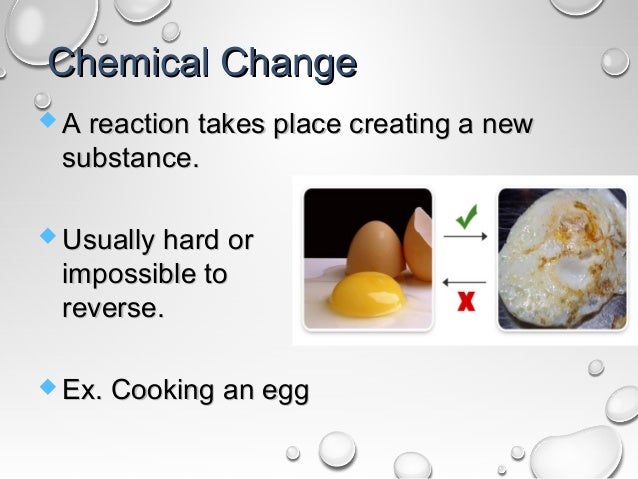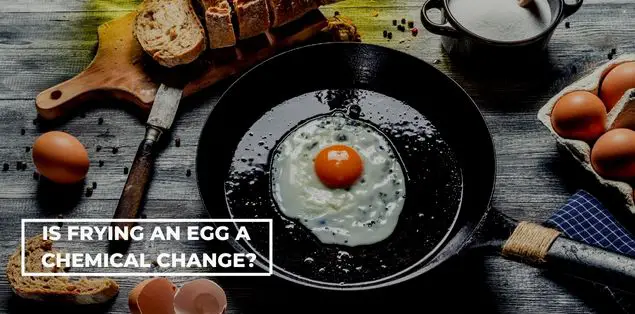
Image: cloudshareinfo.blogspot.com
In the culinary world, frying an egg is a simple yet fundamental technique that transforms a raw ingredient into a delicious, golden-brown delicacy. However, beyond the appeasing aroma and satisfying texture, the process of frying an egg unveils an intriguing scientific question: does it involve a chemical change or a physical change? Understanding this distinction is essential not only for culinary enthusiasts but also for anyone curious about the complex interplay of matter and heat.
Physical Changes: Reversible Transitions
A physical change is a transformation in the form or appearance of a substance without altering its chemical composition. It involves changes in state (solid, liquid, gas), shape, size, or solubility. Physical changes can be easily reversed by altering the external conditions, such as temperature or pressure. For example, melting ice (solid to liquid) or boiling water (liquid to gas) are both physical changes.
Chemical Changes: Irreversible Transformations
In contrast, a chemical change involves a rearrangement of atoms or molecules within a substance, leading to the formation of new substances. These changes are usually accompanied by visible alterations, such as color changes, gas production, or the formation of precipitate. Chemical changes are irreversible, meaning the original substance cannot be recovered by merely changing external conditions. Combustion and the digestion of food are classic examples of chemical changes.
Frying an Egg: A Journey into Chemistry
With the fundamental concepts of physical and chemical changes clarified, let’s return to our culinary endeavor and dissect the process of frying an egg. As the egg is heated in a pan containing fat (e.g., oil or butter), several changes occur:
-
Denaturation of Proteins: The primary protein in egg white, ovalbumin, undergoes denaturation, which means it loses its native structure and becomes randomly coiled. This denaturation is irreversible, causing the egg white to turn from a translucent liquid into a firm, opaque solid.
-
Coagulation of Proteins: As the temperature rises, the denatured egg white proteins form cross-links with each other, creating a network that entangles water molecules. This network further solidifies the egg white, giving it the characteristic rubbery texture.
-
Maillard Reaction: The Maillard reaction is a chemical reaction between amino acids and reducing sugars (such as glucose). It occurs when the egg yolk and white heat up and interacts with the fat or oil. This reaction is responsible for the delightful brown color and caramelized flavor associated with fried eggs.
These changes, driven by the application of heat, result in the formation of new substances: solid egg white, cooked yolk, and flavorful Maillard products. As these changes are irreversible and involve a rearrangement of molecules, the frying of an egg can be definitively classified as a chemical change.
Implications for Culinary Techniques
Understanding the nature of the changes involved in frying an egg is not merely a scientific curiosity but has practical implications for culinary techniques. For instance, knowing that egg white coagulation is a heat-induced process allows chefs to tailor their cooking methods to achieve the desired texture, from soft and slightly runny to firmly set. Additionally, understanding the Maillard reaction helps cooks balance the time and temperature of frying to achieve the ideal balance of browning and flavor.
Conclusion
While the act of frying an egg may seem like a simple culinary task, it unveils a fascinating interplay of chemistry and gastronomy. Through the denaturation of proteins, the coagulation of egg white, and the Maillard reaction, a raw egg undergoes a chemical transformation, giving birth to the luscious, golden-brown delicacy we savor at breakfast or brunch. Whether you appreciate eggs as a culinary delight or are curious about the chemistry behind everyday phenomena, understanding the transformation that takes place when an egg hits the pan adds a delightful dash of science to the culinary experience.

Image: why.do
Is Frying An Egg A Chemical Change Or Physical
https://youtube.com/watch?v=39u-Hz19mAM